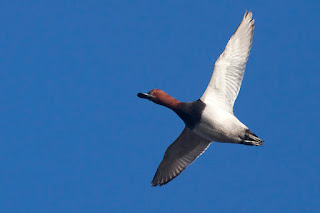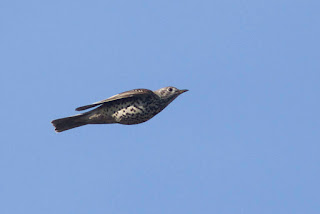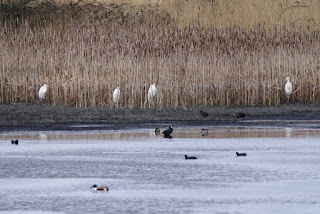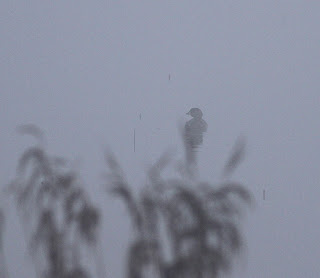It was a beautiful morning on the Avalon Marshes today, a crisp layer of frost, clear blue skies, and not a breath of wind, a welcome change from recent weeks.
The water at Ham Wall RSPB was mostly frozen, forcing good numbers of ducks out into open water. The Pied-billed Grebe had managed to find a small ice-free area in its favoured spot close in front of the second viewing platform, and showed nicely. While watching this, we noticed the drake Ring-necked Duck in with a load of Pochard and Tufted Duck, in another clear patch towards the back edge of this flooded area.
Grey Herons had also been forced out into more visible areas, and several were feeding on the grassy footpaths, something they frequently do when their preferred wet areas are frozen. Of course, feeding on paths means they frequently get disturbed by people walking along, so there were often birds flying low around the reserve looking for a quiet spot.
 |
| Grey Heron |
The ducks were also very mobile, flying from one patch of clear water to the next, often low overhead.
 |
| Drake Pochard |
We had a quick look at the drained lagoon at Shapwick Heath, where only one Great-white Egret was present (along with one Little). A pair of Mistle Thrushes flew over, making their presence known by their loud rattling call, like one of those old wooden football rattles.
 |
| Mistle Thrush |
After breakfast and watching a recording of the cricket back at home (congratulations to Somerset player Nick Compton for his second consecutive century for England by the way!), it was back out to enjoy the sunshine, at Somerset Wildlife Trusts' Westhay Moor.
It really felt like spring here, with a nice warmth from the sun, and various birds displaying and singing. A pair of Buzzards were noisily mewing at each other, and a Marsh Harrier was quatering the reedbed.
 |
| Common Buzzard |
 |
| Marsh Harrier |
The best thing about Westhay is that the hides are located right in the middle of the reed bed, so you really are down in the habitat, giving opportunities to get very close to the birds if you sit and wait long enough. Great Crested Grebes are very common here and one swum right across the front of the North Hide.
 |
| Great Crested Grebe |

















































